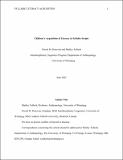Children’s acquisition of literacy in syllabic scripts

View Open
Metadata
Afficher la notice complèteAuthor
Donovan, Nicola
Tulloch, Shelley
Date
2022-06Abstract
This paper, emerging from questions from teachers, parents, and educational policy makers in Canadian Inuit communities, summarizes the results of a literature review of English-language sources addressing children’s acquisition of literacy in syllabic scripts. Specifically, how first language literacy development in Inuktitut syllabics (Qaniujaaqpait) and English or French roman orthography (Qaliujaaqpait) differ (Harper, 2005), together with how learning two different scripts impacts biliteracy acquisition in Inuit children, including those with learning exceptionalities. Unsurprisingly, there are few salient English-language empirical studies, albeit Gleitman and Rozin (1973) demonstrated English-speaking children’s ease in acquiring a 23-symbol English-based syllabary, proposing that syllabaries are a more concrete and effective starting point for early literacy. Limited research concerning Cherokee suggests that syllabics are not objectively harder to learn for mother tongue speakers, but that language loss, alongside ideologies privileging alphabetic writing, may compel preferential use of alphabetic systems for teaching Cherokee literacy (e.g. Peter & Hirata-Edds, 2009). First language literacy acquisition in syllabics is more broadly studied in Asian languages, whereby linguistic awareness (phonemes, syllables, lexemes) was the strongest predictor of learners’ success (cf. Nag & Snowling, 2012). The research suggests that greater understanding of processes and practices supporting children’s acquisition of literacy and biliteracy in syllabics is needed. Still, efforts to strengthen Inuktut oral language proficiency and use, and to enhance overall exposure to and opportunities to read a variety of Inuktut texts, will likely have a greater positive impact on children’s acquisition of Inuktut literacy than efforts to change the script being used.
This research was completed with funding from the University of Winnipeg Research Office - Covid Discretionary Grant.
